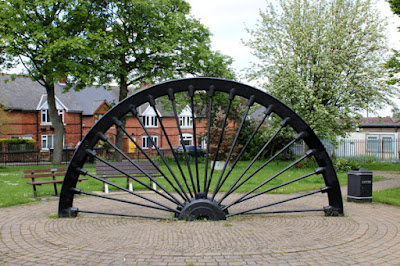 |
| A detail of 'Charge' in Coronation Park |
Continuing my planned walk from St. John’s church to South Anston, having had a quick look at the historic buildings in the hamlet of Throapham, I arrived on the outskirts of Dinnington – a small town that was originally a small farming community, but which slowly grew with the development of quarrying in the area and then rapidly with the sinking of Dinnington Main Colliery in 1902.
Arriving at Coronation Park, there is a simple war memorial in the form of a Latin cross at its entrance, which was unveiled on 12th November 1922. Unlike most war memorials that I have encountered, it is not listed but it provides an example of grey granite from Aberdeen.
When researching my day out, I had discovered that a more recent memorial to the coal miners, who had died and worked at Dinnington Main Colliery, had been unveiled on November 24th 2019 and which I particularly wanted to see.
It consists of a statue of a miner named ‘Charge’ and a memorial wall containing the names of men and women who worked at the colliery, which is made in ‘black granite’ that was sourced and worked in China and has both tooled and polished finishes.
Included in the gardens to accompany the principal memorial wall, there is also a slate covered rose garden with a plaque made of the same polished black granite, which has a dedication with a poem inscribed into it.
Also in Coronation Park, another commemoration of the colliery, whose closure here in 1992 led to the loss of 1000 jobs and long term devastation of the local economy, is part of the headstock – the winding gear at the pit head, which is a feature of all the former coal mining communities.






No comments:
Post a Comment